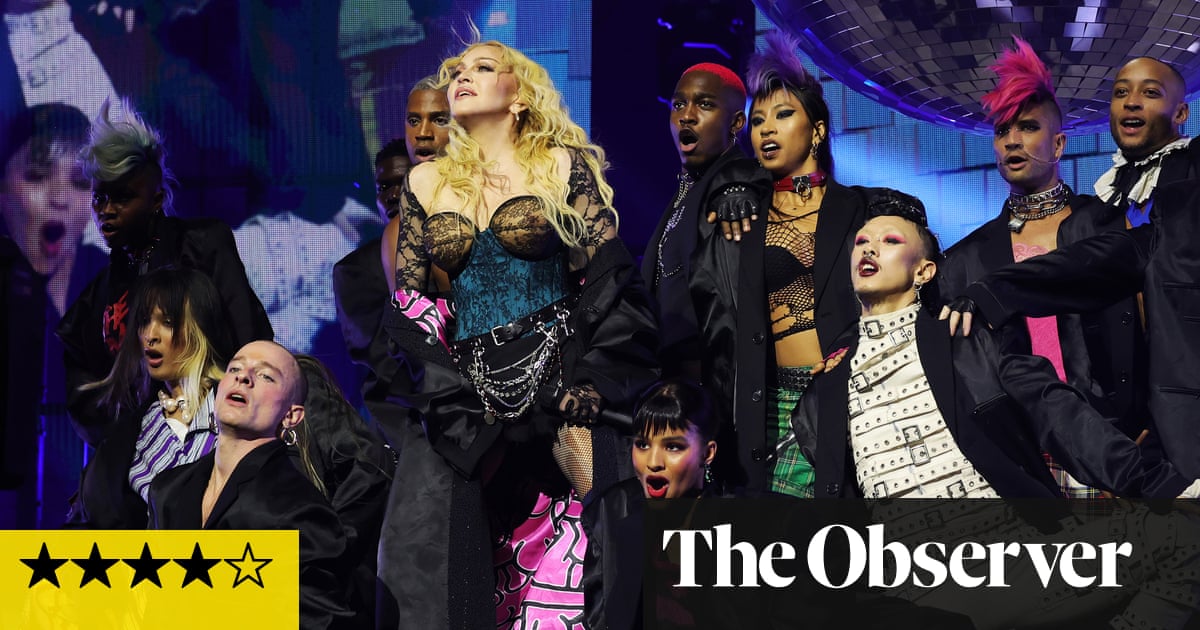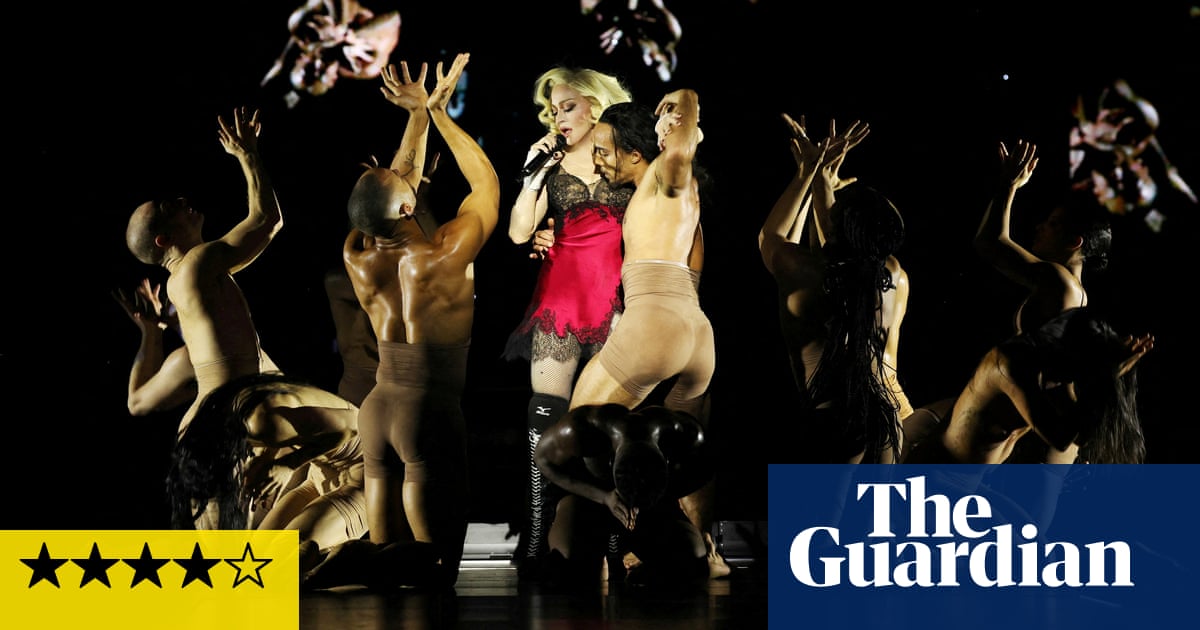
“Have you met me?” asks Madonna drily, a handful of songs into the third night of her Celebration tour. It’s a rhetorical question, given the singer’s hit-saturated 40-year career, her enduring status as the highest-grossing touring female performer of all time, and all the fans who have come in cosplay – not to mention the silly money being charged for VIP tickets. Having long resisted performing greatest-hits sets in favour of staging new work, Madonna recently relented, perhaps prey to a retrospective mood. Since about 2019, she has been trying to mount a self-directed biopic that is now on ice, its energies redirected to charting her career across 78 worldwide dates.
Madonna isn’t just wryly referring to her fame tonight, though. She makes the quip standing next to an avatar of her younger self, a dancer whose face is disconcertingly blurred by a see-through mask. “I’m proud of her,” says Madonna to howls of approval, “she didn’t listen to the naysayers.”
Throughout a two-hour show that romps through her many moods with the aid of impressive multimedia stagecraft and a profusion of dancers, the singer’s doppelganger makes significant cameos. None is more brain-swivelling than when Madonna and her avatar get very steamy with one another on a red velvet bed for Erotica, taking the concept of self-love to uncanny new valleys.
If, according to Philip Larkin, sex began in 1963 between the end of the Lady Chatterley’s Lover ban “and the Beatles’ first LP”, you could argue, at a stretch, that female pleasure began 20 years after that with Madonna’s 1983’s Burnin’ Up (here delivered in a raw, punky form, recalling the time she performed at CBGB’s in New York). That sense of female sexual agency was consolidated by 1984’s explosive Like a Virgin (not used to advantage tonight) and Material Girl (bizarrely left off the set list), climaxing with 1990’s Justify My Love (pretty much a simulated orgy).
There are other Madonnas here as well: the gig’s compere, Bob the Drag Queen, sashays around looking like Marie Antoinette, a nod to Madonna’s look for the 1990 MTV awards. Other key historical Madonna looks are echoed in the dancers’ wardrobes, making her legion.
Significantly, this is a corps de ballet into which Madonna channels not just her historical moves – the dance routines to early songs such as Holiday quote period-perfect 1980s shapes – but her own physicality. If Celebration is an often glorious marinade in Ciccone’s special sauce, that sauce has a bittersweet tang from time to time. Madonna’s heroic choreography has long been a hallmark of her output, but now she wears a leg brace under fishnets. Her movements, though fluent – she walks on chairs, rides dancers and sashays about – are often more gestural than acrobatic. It’s no criticism: a serious bacterial infection delayed the start of this tour, so all 20,000 attendees are grateful she is here at all. Madonna covers Gloria Gaynor’s I Will Survive, but given the show’s montages of old newspaper cuttings (“Hussy!”), video quotes and validatory hurrahs, she could just have easily chosen Frank Sinatra’s My Way or Edith Piaf’s Non, je ne regrette rien.
The enjoyment baseline for Celebration is, then, high: many, many great hits, often rendered in familiar ways, thanks to a band-free production. Live instruments are dotted like confetti: son David Banda’s guitar for Mother and Father; daughter Mercy James’s piano on Bad Girl.
The presence of Madonna’s children is less cloying than you’d think, but there are a few passages where this artist’s choices are more baffling. The avatar’s blank face seems creepy. A celebratory Michael Jackson montage, in which Like a Virgin is merged with Jackson’s Billie Jean, feels a curious choice, given Madonna’s impassioned speech about the suffering of children in the eastern Mediterranean conflict. Far too much time is given over to an interlude featuring The Beast Within, a Book of Revelations-quoting remix of Justify My Love. Its confused desert dance-offs provide an overabundance of styling and little of substance.
Madonna is on much firmer ground when she is rattling the Catholic church’s cage, not quoting from its hymn sheets, or paying homage to the LGBTQ+ community. During one mesmerising segment, half-naked dancers in loin cloths and leather masks hang as though crucified inside a set of carouselling windows. It’ll be interesting to see what Italy makes of this “gimp Jesus” sequence come Milan.
Interpolating the Queens remix of Beyoncé’s Break My Soul, Vogue presents an opportunity for play – an extended ballroom competition in which Madonna (and tonight, Diplo) score the dancers as they cavort up the runway, reiterating Madonna’s allyship to the ballroom scene (even if some have felt differently).
Holiday ends on a sombre note, with Madonna draping her coat over the inert body of a dancer. It’s the 80s and a storm is about to hit. Live to Tell features images of figures who lost their lives to HIV/Aids.
The vast screens surrounding the stage on three sides then split into smaller pictures, then smaller still, counting the many victims of the disease almost ad infinitum. Someone in the crowd releases one red balloon. It a genuinely moving acknowledgment of the suffering that went hand in hand with the decade of excess – and of this Material Girl’s still-compelling emotional range.












